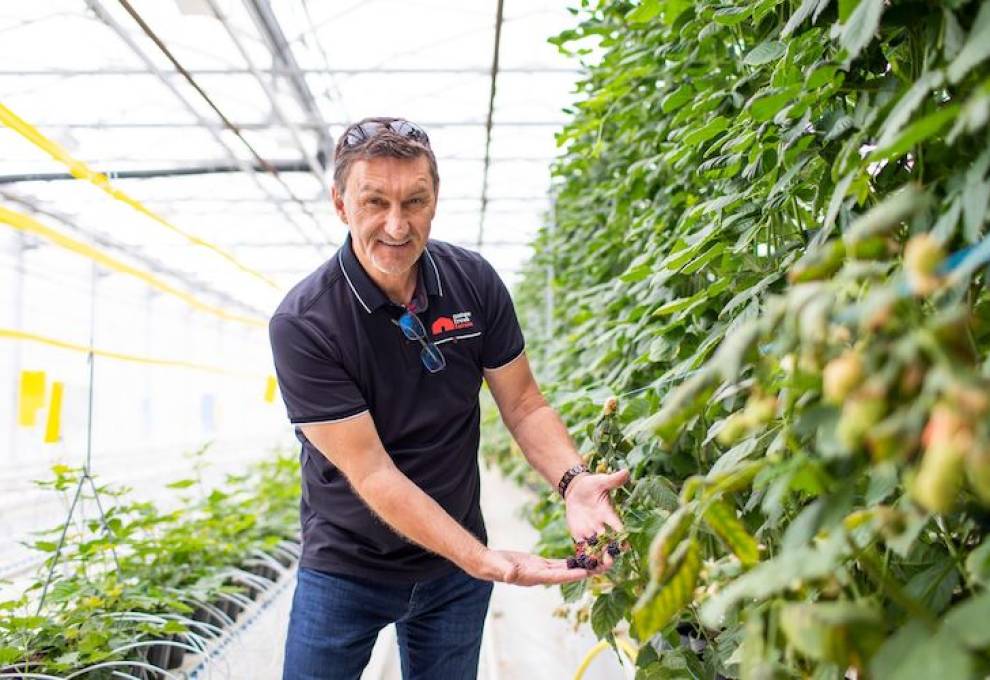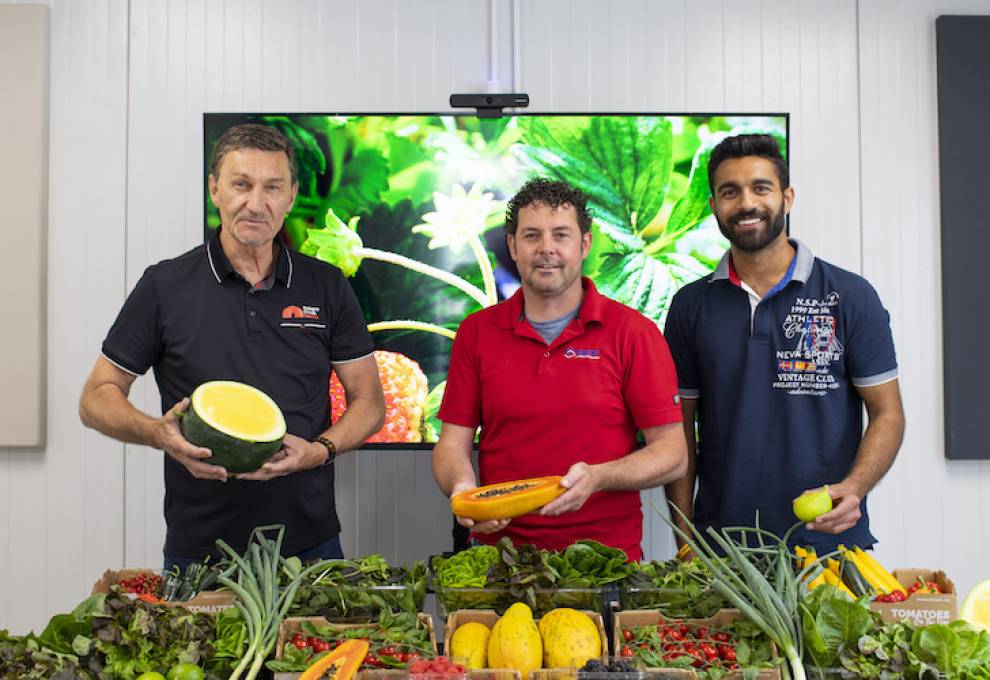

Planet Earth makes one revolution around the sun every year.
This year, Peter Quiring is marking 30 such revolutions of his own. First, as a greenhouse builder founding South Essex Fabricating. Then, as a startup greenhouse grower building Nature Fresh Farms into an internationally respected brand. And today, he’s on a personal mission to expand the foods that can be successfully grown under glass.
“I have no idea of where things are going with this persistent inflation and the results of both good and bad decisions by government,” says Quiring at his Leamington, Ontario headquarters. “I see the future as unstable until this reckless printing of money translating to high interest rates on both sides of the border stops and inflation cools down.”
Uncertainty aside, Quiring is preparing for the future with an R & D Centre that’s literally growing everything under the sun: papaya, figs, melons, limes, bananas, peaches and leafy greens. The category that’s most ripe for expansion right now though, is berries, specifically raspberries and blackberries. Statistics Canada, now tracking greenhouse berry production, reported 2021 sales of $18.5 million with Ontario being the largest producer of greenhouse strawberries at 2.2 million kilograms.
With 2021 strawberry imports to Canada valued at $643 million and an often temperamental climate in the U.S., Quiring sees opportunity to fill the seasonal void of field-grown berries with Nature Fresh-grown product. And he looks to enhance Canadian food security in the bargain.
“We’re really just starting to research what to grow and how to grow,” says Quiring, pointing to blackberries fruiting on trellises. “Varieties are proprietary because everything we do is about taste. We still need to answer the question of whether the quality is better and whether there’s a compelling reason for a retailer to buy our product.”
Agronomic hurdles are the same as with greenhouse-grown tomatoes, peppers and cucumbers -- categories that Nature Fresh Farms have mastered on both sides of the border. R & D head grower Matt Korpan is quick to point out that there are more questions than answers about what climate, lighting and varieties work best. His team of 20 includes specialists in several disciplines: propagation, horticultural crop research, IPM, post-harvest research, consumer tasting, data science, genetics, sensor technology and robotics.
Nature Fresh Farms work collaboratively with seed companies in Holland and California as well as with global leaders in horticultural lighting.
“We have yet to nail down the lighting recipes for each of these new crops under greenhouse conditions,” says Korpan. “Our climate in southwestern Ontario – humidity and light intensity – is much more extreme than in the Netherlands. We have figured out how to control the environment in winter. But in the summer with warm nights and high humidity, it’s about how we take away that heat and humidity.”
To date, there’s little research on blackberries and raspberries in lit greenhouses outside of Holland, Belgium and some Nordic countries. Brambles, members of the genus Rubus, are known for their prickly and rambling bushes that reach across rows in the field. To be economical for harvesting under greenhouse conditions, the plants are coaxed to grow heavenwards on a trellis almost two meters in height. As Korpan elaborates, the goal is to grow blackberries and raspberries in the off season and meet needs outside the high-quality, locally grown, field berry summer market.
“We’re learning about flavour at different crop stages,” says Korpan. “Some varieties are very sweet like a raspberry then the next variety will taste more like a grape or a plum.”
But research on taste is done alongside yield considerations. Under greenhouse conditions, more than one crop cycle is expected, allowing for potentially higher berry yields that might help to offset higher growing costs. And consider this. Brambles need a chilling period. Waking up the plants must be timed so that they are producing berries during the most economically rewarding sales window.
Korpan believes that commercialization of greenhouse-grown blackberries and raspberries may be as little as five years away and getting positive results sooner rather than later is what inspires his team.
Amplifying this approach, Quiring observes, “How research dollars are spent in the western world and particularly in North America should change. Most of the money goes to programs which don’t incentivize commercialization. We would prefer a closer collaboration and communication with the grower community. That’s why we have our own R & D Centre.”
Considering such research is likely to be implemented in Canada, Quiring goes on to highlight a critical obstacle: “There are 640 acres in a square mile. And we have 3,800 acres of greenhouse production in all of Ontario. Space is not the problem. Infrastructure is.”
This point is amply reinforced by the “Growth and Economic Prosperity Study” just published by the Ontario Greenhouse Vegetable Growers (OGVG). Employing an Enterprise Risk Management Framework, the first of its kind by an agricultural sector in Ontario, the study highlights a myriad of risks and warnings.
“Whether it’s water, hydro, natural gas, housing or roads, all of these essential services are in short supply for a greenhouse sector that’s forecast to grow by five per cent annually over the next decade,” says Richard Lee, executive director, OGVG. “For growth to take place, we need the right partnerships with all levels of government.”
Ontario’s greenhouse vegetable sector represents $2.3 billion in gross domestic product contribution, accounts for 81.6 per cent of total Canadian greenhouse vegetable exports and employs more than 32,000 people practising a broad range of skills. Boasting farmgate value of $1.3 billion, Ontario is home to world-class greenhouse expertise with the will to grow. Up to now, a seemingly patchwork approach has resulted in mis-aligned municipal, provincial and federal infrastructure policies and regulations. The gap is widening between industry needs and local services capacity.
Ontario, a place to grow? Is that today? Because for the greenhouse industry, tomorrow is already here.

DIGGING DEEPER PODCAST -- As founder of a greenhouse building company and then as a grower himself, Peter Quiring has witnessed lots of growth over 30 years. Nature Fresh Farms is headquartered in Leamington, Ontario. The Grower is Digging Deeper behind the story above and speaking with Peter about his ambition to grow blackberries, raspberries and leafy greens under glass. He explains how a group of world-class specialists is helping to make that vision a reality. Click to listen >>

Add new comment